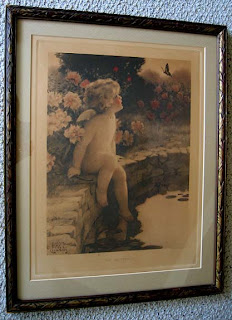"Collecting Tips for Antique Prints"
from Nancy at Victorian Rose Prints
Pitfalls & Prici
 ng Issues: Are there pitfalls associated with collecting old prints? You bet! I can't stress enough the concept of "Buyer Beware". Be informed and diligently do your homework to prevent buyer's remorse. There are many things to consider, but quality is first and foremost. Blemishes, such as rips, tears, repairs, paper ripples, watermarks, and foxing (paper mold) are unsightly and very common in old prints. Many prints were hung over fireplaces. As you can imagine, the air space between the glass and print got very hot, and when it cooled down, condensation occurred, creating unsightly watermarks.
ng Issues: Are there pitfalls associated with collecting old prints? You bet! I can't stress enough the concept of "Buyer Beware". Be informed and diligently do your homework to prevent buyer's remorse. There are many things to consider, but quality is first and foremost. Blemishes, such as rips, tears, repairs, paper ripples, watermarks, and foxing (paper mold) are unsightly and very common in old prints. Many prints were hung over fireplaces. As you can imagine, the air space between the glass and print got very hot, and when it cooled down, condensation occurred, creating unsightly watermarks.In the case of the chromolithograph, the oily inks sometimes caused the print to adhere to the glass. When this happens, it is stuck FOREVER. Removing the print results in tidbits of ink popping off the paper and sticking to the glass. One visual indicator might be little spots of darker coloring throughout the print, or white spots where you can see the
 print has already lifted off the glass. In almost all cases, when the print is taken out of the frame, the print can never be re-aligned perfectly so that the particles line up again. Blemishes in the white margin area of a print can be acceptable, especially if rematting, which would cover the flaws. Some imperfections are easy to notice, and you would think sellers would disclose all problems, but often they don’t see a flaw as a problem area. What is perfect condition to them may not be acceptable in your eyes. RULE NUMBER ONE: ASK QUESTIONS. Small photographs can only reveal so much. Even if you cannot see flaws, ask if they are present. All too often I've see a print description that says excellent, but alas, it has rips, creases, or it might even be pasted to an old scrapbook page! Photographs can easily hide flaws. Again, ask questions, even if does look perfect. Look for a reputable dealer, one who has been in the business for many years, someone with experience who is always pleased to thoroughly answer your questions.
print has already lifted off the glass. In almost all cases, when the print is taken out of the frame, the print can never be re-aligned perfectly so that the particles line up again. Blemishes in the white margin area of a print can be acceptable, especially if rematting, which would cover the flaws. Some imperfections are easy to notice, and you would think sellers would disclose all problems, but often they don’t see a flaw as a problem area. What is perfect condition to them may not be acceptable in your eyes. RULE NUMBER ONE: ASK QUESTIONS. Small photographs can only reveal so much. Even if you cannot see flaws, ask if they are present. All too often I've see a print description that says excellent, but alas, it has rips, creases, or it might even be pasted to an old scrapbook page! Photographs can easily hide flaws. Again, ask questions, even if does look perfect. Look for a reputable dealer, one who has been in the business for many years, someone with experience who is always pleased to thoroughly answer your questions.Price depends on many factors, such as: condition, rarity, and who is aggressively hunting for it (the “gotta have” syndrome). Keep a price in mind, but if you do pay a higher price, you may want to consider finding a print in very good to fine condition. All too often, buyers find themselves with buyer’s remorse after purchasing a print with a major blemish. Afterwards, their eye always focuses on the specific problem area,
 and sadly, they find their treasure disappointing and unfulfilling. Just remember, you can always “trade up”, selling your old blemished print when you find one in better condition. Lastly, don’t let “the thrill of the chase” sway your pricing decision!
and sadly, they find their treasure disappointing and unfulfilling. Just remember, you can always “trade up”, selling your old blemished print when you find one in better condition. Lastly, don’t let “the thrill of the chase” sway your pricing decision!So how does one arrive at the correct price? The internet is a great place to start. Scour the sites you know sell old prints and see what prices they command. Bear in mind that auction or bidding sites are subject to holiday fluctuations. Auction houses are also a source, but remember to ask for additional photos, and ask about blemishes…never take photos you see for granted. With the introduction of the internet, the grand old rose prints, those in superb condition, are indeed difficult to find—it’s as simple as the rule of supply and demand. Old chromolithographs are becoming scarce, there’s no doubt they are extremely popular. So, when you find a rose print that calls out your name, don’t wait too long to make your purchase, as someone else may come in and buy it right out from underneath you!
Tune in Saturday, Feb. 5th, for the age-old question: "Should I reframe my old print?"
Visit our antique prints on Ruby Lane: Victorian Rose Prints
 And on Etsy, for affordable reproduction rose prints: Pink Rose Lady
And on Etsy, for affordable reproduction rose prints: Pink Rose Lady































